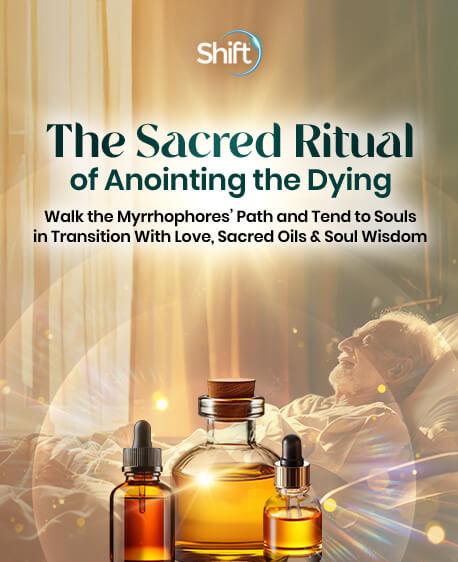William’s wife was on the phone. “He’s fading fast and we don’t think he’ll last the night. Please, will you come as soon as you can to anoint him?”
I dropped everything and jumped in the car to drive the 30 minutes to their home.
As William’s Soul Midwife (end-of-life therapist), I knew that time was certainly running out; he’d gone downhill during the last week.
One of the last things William had made me promise was that I would anoint him with the sacred oil spikenard before he died. William, who had lived with motor neurone disease for three years, believed that spikenard was crucial for helping his soul to transition.
Spikenard is the iconic oil that Mary Magdalene anointed Jesus with the night before the crucifixion. In the Myrrhophore lineage that I belong to, we understand that spikenard prepares us to embrace death and begin the soul’s journey into the afterlife.
Over the year that I had supported William, he often said that death would be his next best adventure. He embraced dying as something exciting, and in most aspects nothing to be afraid of. He said he thought the anointing would help him set off on the journey feeling that the time had come and that he was ready to leave everything familiar behind. So that was the intention that we both agreed on as the focus of the ritual.
Anointing another person is always a sacred responsibility, one that I approach with a deep sense of humility and reverence.
I was shown into William‘s room and could tell by his shallow breathing that he was certainly close to death. Thankfully, he was peaceful and “cocooning” — going deeper and deeper into himself. My heart expanded with love and compassion. I intended to make this anointing happen beautifully with grace and serenity as my final gift to him. Even so, I felt sadness and knew it was the last time that I’d see him. Above all, I knew that my intention must be clear, focused, and pure.
I reached into my bag and found my tiny silver amphora containing the spikenard. Its rich, spicy, ancient scent filled the air, and the room seemed to hold its breath in anticipation.
I lit a candle and sat for a few minutes holding William’s hand, reassuring him and gently explaining that I was with him, that he was loved and safe. “You are doing so well,” I whispered. His eyelids flickered and he gave me a tiny smile. Hearing is the last sense to go, and I knew that he knew I was with him.
I dipped my fingertips into the oil, and as I touched William’s forehead I felt a surge of emotions wash over me. In that moment, I recognized his vulnerability and the trust he had placed in me, and the weight of the moment became even more profound.
As I anointed him, opening my heart wide and connecting on a deep level with his, I found myself humbled by the experience. This anointing was not about me; it was about the sacred act unfolding before us. Anointing another person is always a reminder that we are merely a conduit for divine grace and healing. It was a moment of deep connection with something greater than myself, a recognition that I was part of a sacred lineage of healers and caregivers who had performed this ritual for generations.
Anointing is not about having all the answers or possessing a certain level of expertise. It is about showing up with an open heart and a willingness to be present for another soul's journey. Anointing requires us to set aside our egos, to surrender any feelings of inadequacy or self-importance, and to trust in the power of the sacred act itself.
With each dab of the oil, I feel a sense of surrender in William and a letting go of any need to control or direct the outcome. I embraced the uncertainty and the vulnerability, knowing that in such moments of rawness, true healing can take place.
This was not about me wielding some magical power; it is always about being a vessel for love and compassion.
As I completed the anointing, the atmosphere of the room shifted, becoming soft and full of light.
William lay peacefully in his bed, his breathing easier and a profound sense of peace enveloping us both, Nora, his wife came in and joined us, and we sat on either side of the bed holding William’s hands.
In that tender space of transition I felt we both connected with something deeper, and a wellspring of compassion and love flowed between us.
Anointing is not a performance or a show of prowess; it is a genuine expression of care and reverence for the other person's wellbeing. You do not need to be a priest or holy person; it’s a gift that we can all give to another.
William died that evening. I knew exactly when and didn’t need the phone call later that evening to confirm it. I had already felt William’s soul leave his body; he was free at last.
In the days that followed, I reflected on the anointing experience. It had taught me a valuable lesson — one that would continue to guide me in future acts of anointing. I learned that anointing was not about having all the answers or being perfect in execution. It was about showing up with authenticity, a genuine desire to be of service. and keeping a “soul promise.”
As I continue to anoint others in my work with the dying, I approach each moment with the same sense of humility.
Each person I anoint is on a unique soul journey of their own. My role is simply to hold space for them and offer my love and blessings. Anointing before death is a call to surrender, a presence, a sacred communion between souls.
The act of anointing is also a source of joy and fulfilment, a reminder of the interconnectedness of all beings and the power of compassion to heal and transform. In every act of anointing, I find myself humbled once again, in awe of the sacredness of the human spirit and the infinite possibilities that lie within the realm of the heart.
Many years have passed since I first stepped into the role of a Myrrhophore, anointing with sacred oils. Over the decades, there’s been a transformation in the popularity and significance of this ancient practice, and it fills my heart with awe and wonder to reflect upon the reasons behind this profound shift.
Anointing is thousands of years old, a deeply revered but relatively obscure ritual preserved within the realms of religious and spiritual traditions. It holds immense cultural and historical significance, yet its reach has been limited to the devout and the devoted.
We are now in a time of collective yearning for deeper meaning. The world, with its relentless pace and ever-changing landscape, seems to beckon us to look inward, to seek sanctuary in the Divine. Anointing with sacred oils calls out to the soul’s craving for the sacred, a respite from the cacophony of modern life.
It has found a home in the hearts of those who sought a comprehensive approach to wellbeing — one that embraced the interconnectedness of body, mind, and spirit. Anointing has also become a ritual of self-care, a tender act of acknowledging the sacred within ourselves.
It extends an invitation to be present in the moment and to cherish the grace of the divine touch. In an age of fleeting distractions, the anointing ritual provides a timeless space of reflection and connection.
As rituals became more accessible, their inclusive nature embraces all seekers of truth, regardless of their spiritual paths. Anointing becomes a universal language of love, compassion, and unity — a gentle reminder that beneath the diverse selection of beliefs, we are bound together by a common thread of shared humanity.
So now is the time to bring out your oils and work with your hearts and hands. With each drop of sacred oil, we anoint not only our bodies but also our spirits, opening ourselves and others to the Divine and the deep mysteries of existence.
If you're interested in learning more about this, save a spot to attend my free introductory online event on Saturday, April 19, titled The Sacred Ritual of Anointing the Dying: Walk the Myrrhophores’ Path and Tend to Souls in Transition With Love, Sacred Oils & Soul Wisdom.







